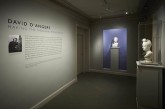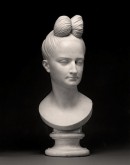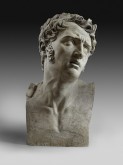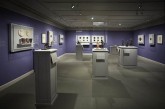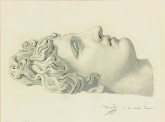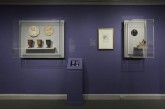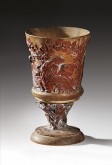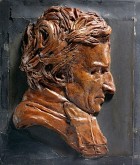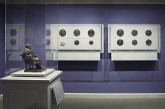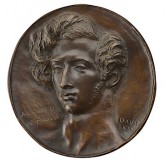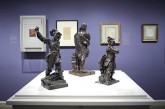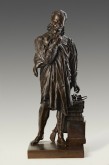The browser will either open the file, download it, or display a dialog.
David d’Angers: Making The Modern Monument
The Frick Collection, New York
September 17 – December 8, 2013
Catalogue:
David d’Angers: Making The Modern Monument.
Emerson Bowyer, with Jacques de Caso.
New York: The Frick Collection, 2013.
112 pp.; 95 color illustrations; chronology, bibliography, index.
$19.95
ISBN: 978-0-912114-59-0
Some artists are hidden in plain sight. One wonders how many thousands of people walk past the Panthéon in Paris every day, scores of whom glance upwards, albeit fleetingly, towards the sculpted pediment by the highly productive Romantic sculptor Pierre-Jean David, known as David d’Angers (1788–1856). Are they at all moved by the phrase below the sculptures, which reads “Aux grands hommes, la Patrie reconnaissante [To Great Men, the Grateful Nation]”? Granted, there is not a lot to be felt or seen: the façade of the Panthéon is well overdue for a scrub-down, and the multitudes are, these days, looking downwards at their devices rather than upwards towards the vision of the apotheosis of their forefathers.[1] David, the Phidias of his era, sculpted the great men of history in the pediment, laying bare his own Republican leanings in the turbulent year of 1830. The Panthéon pediment was the epitome of the modern monument in its time: David included heroic men whom he admired, adorning them with modern clothing and giving them pride of place, and he defended his choices for the pediment when the politics of rulers of the July Monarchy (1830–48) became more severe. David also made monuments for cemeteries, had the forethought to create a museum of his works in his birthplace of Angers during his lifetime, and, in a continuation of the idea of a pantheon, made hundreds of portrait medallions of great persons of his day. Yet, according to the press release for the recent exhibition David d’Angers: Making the Modern Monument, held at the Frick Collection, David remains “little known.” This, I think, is a bit exaggerated: scholars of nineteenth-century sculpture do know quite well who David d’Angers was, and there has been a fair amount of new research on his works published very recently by scholars such as Jacques de Caso, Dorothy Johnson, Thierry Laugée, Isabelle Leroy-Jay Lemaistre, and Suzanne Glover Lindsay [see my review of Lindsay’s book Funerary Arts and Tomb Cult, Living with the Dead in France, 1750–1850, in this issue of NCAW Pierre reviews Funerary Arts and Tomb Cult]. Thus, David is always there, physically in front of us in Paris at the Panthéon; at the cemetery of Pére-Lachaise; in his sculpture of Georges Cuvier at the Musée d’histoire naturelle; in his modifications to the Arc de Triomphe du Carrousel; and in the current textual research. He is there, in plain view. The issue is simply that we have not been looking up, and thus we have not been paying him the full attention that he and his works deserve.
David d’Angers: Making the Modern Monument, which served to correct our negligence (or, at least, the American neglect of the artist) was held at the Frick Collection in New York this past fall and was guest curated by Emerson Bowyer, a former Andrew W. Mellon Curatorial Fellow there. It was a small but solid presentation containing twenty-eight bronzes, six drawings, five plasters, four wax-based sculptures, two terracotta sculptures, one marble, and two books (from 1867 and 1883) cataloging David’s medallions. The exhibition space, on the lower level where special shows are usually held at the museum, consisted of an entranceway containing two busts, and one room displaying the remaining forty-four works; it sought, however delicately, to reintroduce David to a new, particularly American, audience. [Please view the 360° Virtual Tour of the Exhibition, using the link below. www.frick.org: “virtual exhibition” ] It was the first exhibition devoted to David d’Angers held outside of his native France, the Frick Collection was the show’s only American venue, and the forty-six works were lent primarily by private collectors and American institutions.
The exhibition opened (fig. 1) with two striking works, well-balanced by a marble bust of a woman, a portrait of Ann Buchan Robinson, wife of the shipping magnate Captain Henry Robinson, from 1831 (fig. 2), and David’s winning tête d’expression plaster entitled La Douleur (Pain), from 1811 (fig. 3). The latter demonstrates David’s early interest in and understanding of anatomy as well as displaying heightened emotion in the usually static medium of sculpture. La Douleur is a curious amalgamation of classicism and Romanticism avant la lettre: the anatomical correctness, blank eyeballs, and light band around the head are details that show the artists understanding of classical sculpture, while the furrowed brow, parted lips, free-flowing curls of hair and ever so lightly tooled mutton-chop style sideburns give the figure a modern touch and an emotional quality that points towards the Romantic era with which David is more closely associated. The exact nature of the pain expressed in La Douleur is difficult to determine–it wavers between physical agony, emotional trauma and sexual climax–and therein lies the real genius of the sculpture. By contrast, the bust of Ann Buchan Robinson, sculpted twenty years later and more firmly rooted in the Romantic period proper, is unexpectedly cool, reserved, restrained and more classical in its presentation. Made with the American patrons in mind, it likely reflects American tastes more than that of the French. Thus, we begin the exhibition with the enigma that was David d’Angers, entrenched in his training at the Ecole des Beaux-Arts in Paris under the tutelage of Philippe-Laurent Roland (1746–1816) and the other David, Jacques-Louis (1748–1825), he was guided by a personal admiration for ancient classicism and Renaissance art, and yet his works were also deeply emotional, energetic, political, and fueled by his republican principles, which led to the creation of a different form of modern sculpture.
Turning into the Lower Level gallery to the right (fig. 4), the exhibition continued on the left wall with a two drawings, Study after a Plaster Cast of the Apollo Belvedere (fig. 5) and General Bonchamps Shown in a Pose Designed for His Tomb (recto shown, 1824), and small bronze version of the Monument to Bonchamps from the same year as examples of David’s early works. The history of the monument dedicated to Charles-Melchior-Artus, marquis de Bonchamps (1760–1793) was recently and deeply treated by Lindsay in her book reviewed here Pierre reviews Funerary Arts and Tomb Cult, and is in fact David’s most important monument.[2] As he lay dying, the conservative Bonchamps asked that the 5,000 republican revolutionary prisoners, held at the church of Saint-Florent-le-Vieil, be pardoned. David’s own father was among the prisoners released, and although the artist did not reveal that information to the parties in charge of the commission, he was nevertheless selected for the project in 1818. The drawing for the monument, lent by the Metropolitan Museum of Art, and the small bronze edition of the final tomb project were important, necessary contributions to the exhibition.
Five lesser known, but quite wonderful, works shown nearby were David’s plaster medallions of his son Robert and daughter Hélène (fig. 6), displayed in a Plexiglas, wall-mounted case with three versions of his Christening Cup (figs. 7, 8). While I remain unconvinced by the assertion in the catalogue that the two medallions represented the children as the allegories of the senses of taste and smell, I was more persuaded by Bowyer’s contention that “sensual immediacy, unaltered by the process of socialization, marks the innocence of Robert and Hélène.”[3] Both plasters are wonderfully tooled with delicate markings in the bonnets, hair, and matching beaded necklaces that adorn both children. The christening cups continue the theme of childhood innocence, and, to a greater extent, illustrate the development of socialization and national pride in children. According to the catalogue, the cup was first designed on the occasion of Robert’s baptism in 1835, and it depicts the four stages of childhood: nursing; self-nourishment; literacy; and civic awareness.[4] The iconography was quite unique, and a digital device with a touch screen mounted at the right of the display allowed visitors to “turn” the cups and enlarge the views to see the progression of the narrative and each of the three versions in great detail. Often I find digital devices in exhibitions to be distractions, and just another modern obstruction (like the ubiquitous and offensive audio guide, and the newest menace, the “fake eye,” that is, the smart phone with non-flash photography capabilities) that prevents viewers from actually looking with the eyes in their heads at the unique work of art in front of them. However, this device that assisted with the presentation of the christening cups had a purpose, and allowed visitors to look at the backs of the cups and other views and to zoom into details that were otherwise difficult to see with the naked eye. This interactive feature created for the christening cups remains available on the Frick’s website (www.frick.org: “christening cups interactive”).
After viewing three representations of female figures (a drawing entitled Head of a Woman in Profile; a small terracotta called Seated Woman, and a bronze medallion of Cecilia Odescalchi, David’s first love), the visitor was presented with two wax on slate portraits and the two bronzes made from them. One of these sets, the portrait of the Abbé de Lamennais in wax and bronze (figs. 9, 10), both from 1831, exemplified well David’s working method. Showing these works side-by-side also highlights, for better or worse, the various details that are lost after the work in wax is transferred into bronze. In viewing the Abbé de Lamennais works together, I felt that there was a loss of the freshness and immediacy of the wax in the bronze translation, particularly in the cravat and in the hair. Visitors were told in a wall label that few of the original wax models for the medallions have survived, so it was a special event to see the Abbé de Lamennais and the portrait in wax of Émile Deschamps (1829), in the same display case, all from private collections.
The far wall of the exhibition, parallel to the entrance, held two display cases containing eleven bronze portrait medallions and one plaster medallion (fig. 11). Although David created large-scale and truly monumental public works, his fame rightly lies with his revival of the cast bronze portrait medal, a sculptural type, which originated in the Renaissance. The single-sided works, created over a period of almost forty years, depict around five hundred of David’s contemporaries. Most often the subjects are shown in profile, a format associated with ancient coins. Not one of the medallions was commissioned by the sitter, and David received no financial remuneration from their creation. At the Frick, in addition to the medallions shown earlier and later in the exhibition, in these two cases visitors were presented with bronze medallions of François Arago (1834); Rosa Bonheur (1854); Alexandre Dumas (1829); Caspar David Friedrich (1834); Théodore Géricault (1830); Victor Hugo (1828); Alfred de Musset (1831); Niccòlo Paganini (1834); Louise Swanton-Belloc (1830); Mélanie Waldor (1835); and Frédéric Louis Zacharie Werner (ca. 1830s). A medallion of the painter Victor Schnetz (1828), in plaster, was also displayed here. As David selected his subjects from his personal circle, we are presented with, as noted by Bowyer in the catalogue, “David’s complex and extended social network, an interconnected and international web of figures encountered at salons, dinners, professional events, and through introductions by friends, family and acquaintances.”[5] I could not resist the thought that I was looking at a selection of David’s Facebook page, his “wall” teeming with more than five hundred “friends.” The portrait medallion of Alfred de Musset (fig. 12), like that of Géricault and Werner, presented the subject in a three-quarter view, unusual for David as he preferred the profile view. David’s fascination with physiognomy and phrenology in connection with the medallions is discussed by Bowyer in the catalogue.[6] Nearby in a separate case were two books that featured images of the medallions. The first, Les Médaillons de David d’Angers (1867), contained 447 albumen prints attributed to Etienne Carjat taken from the plasters, as photographs of bronzes often failed to capture details. The second book, published in 1883, contained mechanized engraved images of some of the medallions.[7] Books and ephemera always add a nice touch and give context to the works on view, and these two books were evidence of the importance that the medallions retained after David’s death. Additional bronze portrait medallions of Jean-Antoine-Dominique Ingres (1826), François-Marius Granet (1827) and Eugène Delacroix (1828) followed on the next wall on the right.
While there was no press image available for David’s Study for a Tomb Relief for the Duchess d’Abrantès (1841), I would like to mention it here. The drawing was among the most detailed in the exhibition and is an example of a rare concept for a public monument dedicated to a female artist. Known for her wild extravagance and witty though biting memoirs, the tomb monument to Laure Junot, Duchess of Abrantès (1784–1838) was never erected as David had planned. The drawing gives us a rare glimpse of what the reliefs for the tomb may have looked like. I found myself wanting some more information about David’s funerary œuvre, which, apart from the Bonchamps-related works, was somewhat lacking in the show. David completed quite a few sculptures, for example, in the Cemetery of Père-Lachaise including a Monument to General Foy (1825–1831), created with Léon Vaudoyer; a bust of Samuel Hahnemann (1837), father of homeopathic medicine; a bust of Honoré de Balzac (1844); and a monument to General Gobert (1847).[8] There is no greater pantheon than Père-Lachaise, yet the stories behind David’s most visible funerary-related works in Paris were, for the most part, omitted from the exhibition. In the curator’s defense, though, there may not have been many easily attainable artworks for the show that would help to exemplify these other funerary projects. One can only work with the material that one has available.
David also created allegorical images, and a bronze Liberty (1840), included in the exhibition, was a highlight among the sculptures in the round that were presented. David’s version of liberty is a wonderful sculpture with all of the right iconographic symbols: standing on shackles, Liberty holds a bayonet in her left hand and a wreath of laurel leaves in her right hand. A Phrygian cap tops a masculine face, at the pinnacle of a female body. The wall label stated that David had written that he “made [Liberty] so it could be purchased by the people . . . Let us hope that one day we will see the image of Liberty in humble homes. She is a saint who well deserves the most fervent cult.”[9] How enthusiastic he would have been to see the “New Colossus,” Frédéric-Auguste Bartholdi’s Liberty Enlightening the World, conceived in 1870, just fourteen years after David’s death.
In the center of the gallery, additional small sculptures of historical figures, sculpted in the round, were displayed. Three bronze sculptures, The Grand Condé (1817), Jean Bart (1845) and Ambroise Paré (1840) were shown on an open base directly across from Liberty (fig. 13). These sculptures are reduced versions of three of David’s most important public commissions. The Grand Condé marks David’s earliest commission, received just after his return to France from Rome after his Prix de Rome, and passed on to him after the death of his teacher, Roland. The large marble Condé created for the Pont Louis XVI (now the Pont de la Concorde) was destroyed in World War II, but plaster and bronze versions survive of this energetic sculpture which, in its swish and swash of drapery, hair, feathers and arms, has all the dynamism and kinesis one sees in much later Romantic works; clearly David was ahead of the times. The sculpture of the French naval commander Jean Bart from 1845 owes much to the earlier sculpture of the Condé. In between the two was the sculpture of the Renaissance-era military physician Ambroise Paré (fig. 14). Deep in thought, Paré is also ready to act: his left hand reaches for a surgical instrument, while his rifle rests against his medical books. The bronze of Paré was available in four sizes through the Barbedienne Foundry through the late 1880s. The Ambroise Paré on view at the Frick was the largest sculpture in the exhibition, and was a close example of the largest size of the sculpture available through Barbedienne in the nineteenth century, at 47.7 centimeters (Barbedienne had the work available as a “grandeur d’exécution” at 49 centimeters).[10]
A word should be said here about David’s use of various Parisian foundries. While David did not authorize the medallions for reproduction in multiple bronze editions, some of his sculptures in the round did find their way into catalogues such as Barbedienne’s. In just the bronzes exhibited here, there were examples of bronze casts made by the founders Louis Richard (active around 1830); Eck et Durand (active around 1840); Richard and Eck and Durand together (active around 1839); Thiébaut Frères (family business active during the nineteenth century, roughly 1834–1900); and François Barbedienne (opened in 1838, closed in 1953).[11] Bowyer notes in the catalogue that “the subject of David’s founders has yet to be fully studied,” and I would add that the study of nineteenth-century foundries in general could stand to have a team of scholars who would contribute to a large (preferably online) project that would further our understanding of these essential members of the art-producing community. Having the groups of small-scale bronze casts on view here from a variety of the top foundries active at mid-century was a lesson in itself, and I found the casts by Thiébaut Frères to be, in comparison with the others on view, most superior. The bronze cast of Philopoemen (1837) was brushed with a patina that turned the metal a light brown color, which was a brighter patina than the rest of the works on view. This cast also contained fine details in the sword sheath and in the centurion helmet. The cast of Liberty, also produced by Thiébaut Frères, was equally sumptuous.
The catalogue for the exhibition is a small, fine tome in full color, containing a brief chronology of David’s life; an essay by Bowyer which focuses specifically on the sculptures in the show; a brief essay by Jacques de Caso on David as a writer, which also acted as a preface to a piece of writing by David; and a translation this piece of writing, an untitled vignette written by David and originally published in 1849 in the journal Démocrate de l’Ouest. De Caso’s essay asks us to consider the “tenacious prejudice concerning writings by artists,” which still exists among scholars.[12] In the nineteenth century most artists wrote, and while I think it would be a fallacy to believe that just because they wrote, they wrote well, it is true that some wonderful writing came from artists’ pens during the period, and David was exceptionally prolific in this regard, particularly in the areas of correspondence, notes and published texts.[13] De Caso elegantly prefaces the untitled piece, and reminds us to consider David’s political leanings and motivations when reading it. David’s untitled story was published just one month before the June Days Uprising, and at a moment when David’s own stint in politics was ending. The vignette is a short, sad tale of a widow singing for coins on the Pont des Arts with her infant child. She is ignored by most, except by a worker, almost as poor as her, who gives her alms. “Oh Republic so dear,” David asks, “so patiently awaited, bought by so much blood and tears, under your noble reign should such dramas unfold, such sorrows still be seen?”[14] As in 1830 with his Panthéon pediment figures, David, with this brief chronicle, revealed his politics to the public.
While it is always difficult to explore the works of an important artist who made very large, public, unmovable, sculptures in a small show such as this was, the presentation was well done at the Frick Collection. One left the exhibition with a greater understanding of the political challenges that face the best artists (that is, the artists who care about the world and the people around them), and with a greater understanding of David’s own prolific output, even though the assortment of works presented was limited to a small selection of sculptures. Surely it inspired viewers, as it did me, to make a future visit to the Galerie David d’Angers, located inside the thirteenth-century L’Abbatiale Toussaint in Angers, less than 200 miles southwest of Paris. It also made clear that David is an artist well deserving of the recent outpouring of research on him, and is also worthy, someday, of an even larger exhibition in the United States. The exhibition at the Frick Collection was the “entrée” to an extravagant meal not yet served to us. After viewing this exhibition, we see the David we already knew, but we see him more clearly; he comes into better focus. Now we are looking up.
Caterina Y. Pierre, PhD.
The City University of New York at Kingsborough Community College
caterinapierre[at]yahoo.com
caterina.pierre[at]kbcc.cuny.edu
Related Links:
Website for the Frick Collection, New York: http://www.frick.org/
Official Press Release for David d’Angers: Making the Modern Monument: http://www.frick.org/sites/default/files/pdf/press/release_heading_0.pdf
Link to the David d’Angers: Making the Modern Monument virtual exhibition: http://www.frick.org/exhibitions/d%27angers/virtual_exhibition
Link to the complete set of lectures hosted at the Frick Collection for this exhibition: http://www.frick.org/exhibitions/d%27angers/videos
Webpage for the Galerie David d’Angers: http://musees.angers.fr/les-musees/galerie-david-d-angers/le-lieu/index.html
Cimetière du Père-Lachaise Website: http://equipement.paris.fr/cimetiere-du-pere-lachaise-4080
I would like to extend my deepest gratitude to Heidi Rosenau, head of Media Relations and Marketing at the Frick Collection, for her assistance and for providing me with press materials, web links and all of the photographs for this review.
[1] The Panthéon restoration project is currently in the planning stages, but one-hundred million euros are needed to complete the project. See Claudia Barbieri Childs, “Facelift for Panthéon, Paris’s grand dame,” The Art Newspaper 244 (March 21, 2013),
http://www.theartnewspaper.com/articles/Facelift-for-Panthon-Pariss-grande-dame/28959.
[2] See Suzanne Glover Lindsay, “The Bonchamps project: Reinventing the effigy tomb,” in Funerary Arts and Tomb Cult, Living with the Dead in France, 1750–1870 (Surrey, England and Burlington, Vermont: Ashgate, 2012), 95–118.
[3] Emerson Bowyer, “David d’Angers: Making the Modern Monument,” in David d’Angers: Making the Modern Monument (New York: Frick Collection, 2013) 45–46.
[4] Bowyer, 53–54.
[5] Bowyer, 47.
[6] Bowyer, 39–50.
[7] These books were Les Médaillons de David d’Angers (Paris: Ch. Lahure, 1867) and Les Médaillons de David d’Angers. Collection de 125 Planches, accompagnée d’un portrait de David d’Angers, grave d’après d’Hebert, et précédée d’une Préface par Émile-Soldi (Paris: A. Lévy, 1883). The former was lent by a private collector and the latter was lent by the American Numismatic Society.
[8] On the General Foy commission, see Nadine A. Pantano, “Liberal Politics and the Parisian Cemetery: David d’Angers and Léon Vaudoyer’s Monument to General Foy, 1825–1831,” in Oxford Art Journal 20:1 (1997): 23–34.
[9] Bowyer, 54. The full quote was reproduced only on the wall label, which was made available to the press in the document entitled “David d’Angers labels, Printed Version, 3 Sept 2013.”
[10] Bowyer, 52.
[11] A good starting point for researching French foundries remains Robert Kashey and Martin L.H. Reymert, et. al., Western Bronzes of the Nineteenth Century: A Survey (New York: Shepherd Gallery, 1973).
[12] Jacques de Caso, “David d’Angers and the Necessity of Writing,” in David d’Angers: Making the Modern Monument (New York: Frick Collection, 2013), 70.
[13] De Caso, 73.
[14] David d’Angers, “Untitled/Sans Titre,” in David d’Angers: Making the Modern Monument, trans. Jack D. Johnson (New York: Frick Collection, 2013), 89.


